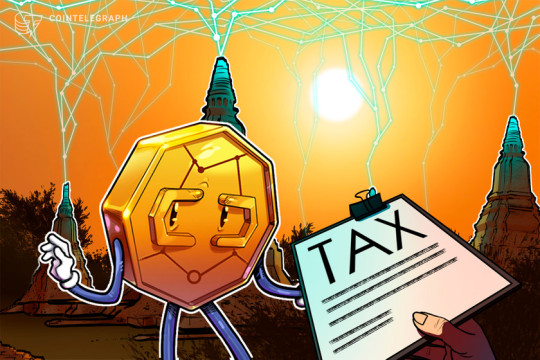Text
Bitso to Offset Carbon Emissions From the Trading Platform's BTC, ETH, ERC20 Transactions – Bitcoin News
Bitso to Offset Carbon Emissions From the Trading Platform’s BTC, ETH, ERC20 Transactions – Bitcoin News
On Friday, the Latin American cryptocurrency platform Bitso announced that the company plans to offset carbon emissions from its bitcoin and ERC20 token transactions carried out on the platform. Bitso is partnering with the carbon offset platform Moss.Earth in order to curb the crypto company’s environmental impact.
Bitso to Offset Crypto Transaction Carbon Emissions by Partnering With…

View On WordPress
1 note
·
View note
Text
What should I do if the miner cannot be started?
If your miner fails to start normally, you can troubleshoot with the following methods.
Check the voltage.
If your voltage is lower than the starting voltage of the power supply, the power supply will not work, which will cause your miner to fail to start.
The voltage varies by country and region. Most countries are 110V or 220V or 240V, and different voltages output different power. Make sure that the power supply voltage provided by your country or region can be converted into enough power for your miner.
Generally, if your miner needs more than 1200W of power, your socket must provide 220V. If 220V is not available in your country, you can have an electrician configure the wiring, or use a mini power transformer to convert the voltage.
Check the power supply.
You can test the miner with the working power supply to see if the working power supply can supply power to the miner. If another working power source can be connected to the power supply, the PSU will not work properly.
Check the control board, and then check the hash board.
If the miner still fails to start after the above two methods, please disconnect all cables connected to the hash board. Only connect the power connector to the control board.
0 notes
Text
German banking giant Commerzbank applies for crypto license
German banking giant Commerzbank applies for crypto license
One of the largest banking institutions in Germany has confirmed it applied for a local crypto license earlier this year, marking the first time a major bank has made a move toward cryptocurrencies in the country.
A spokesperson from Commerzbank confirmed to local media outlet Börsen-Zeitung on April 14 that it “applied for the crypto custody license in the first quarter of 2022.” If approved it…

View On WordPress
1 note
·
View note
Text

How to fix low hash rate
When the local hash rate of the miner is less than the theoretical hash rate of the miner, you can refer to the following troubleshooting methods to locate and solve the problem
1) The miner is not preheated, resulting in an insufficient hash rate when it is turned on.
Solution: It takes about 15 minutes for the miner to restart, and the hash rate can reach the normal range after this time. If the miner automatically restarts within a few minutes, please replace the power supply and test to confirm whether the restart is caused by an abnormal power supply.
2) The miner's hash board is not fully displayed.
Solution: If the number of hash boards displayed on the backend of the miner is less than the number of hash boards of the miner, you need to re-plug the data cables at both ends of the hash board (or update the damaged data lines), and restart the operation.
3) Abnormal temperature sensor data results in no hash rate.
Check the hash board online in the miner's background, if the hash rate is 0, the number of chips is displayed as 0, or the temperature is abnormal (the temperature is different from other hash boards). Please unplug the data cables at both ends of the hash board and reconnect them.
There are many reasons for the low hash rate of miners, which should be analyzed according to the specific situation. I hope some of the references I have provided will help you.
For more details, please check Reasons and how to deal with the drop in miner hash rate
0 notes
Text
1 note
·
View note
Text
Antminer T17 hash board repair guide (2)
Today, I will continue to share the parts that are prone to failure on the Antminer T17 hash board and the common repair methods.
The fifth wearing part solid capacitor (330 30V)
There are 6 30V solid-state capacitors 330 on the whole board, 5 on the right side of the front of the hash board, and 1 on the left side.
Its main function is to filter, rectify and store energy. The 5 capacitors at the power input interface of the T17 hash board (right side) are mainly used for filtering and rectification. If one of them is damaged, it will cause the abnormal voltage on the hash board and damage other components. Capacitors close to the inductor (on the left) are primarily used for rectification and energy storage. After damage, it will affect the work of the booster circuit and cause the hash board to not work.
The sixth consumable part EEPROM memory (02DMCN)
This component is mainly used to store EEPROM data and is located at the upper left of the back of the hash board. If the chip is damaged, the whole miner will not be able to run because there are 3 hash boards in the Antminer T17, and these hash boards must keep the same EEPROM data to be recognized by the control board. If one of them is damaged, the miner will report an EEPROM error in the background and stop booting.
The seventh vulnerable part low dropout voltage regulator chip (MP2019). The low dropout voltage regulator chip (MP2019) is located at the upper left of the reverse side of the hash board. The main functions of this component are over-voltage protection, over-current protection, and over-temperature protection, with an integrated MOSFET. After damage, it will cause abnormal voltage in the voltage domain, or no voltage, under-voltage, and other faults, resulting in the inability of the miner to run.
Eighth consumable part boost converter chip (MP1517DR)
The boost converter chip (MP1517DR) is located at the top left of the front of the hash board. Its main function is to detect and control and adjust the output voltage of the booster circuit of the hash board in time. The internal integrated FET voltage regulator module will cause no voltage MOS circuit part on the back after damage. When the chip fails, the MOS test output is normal, but there is no voltage in the voltage domain.
The above vulnerable parts can be tested with test fixtures, regular inspections, and timely replacement can reduce unnecessary losses.
0 notes
Text

Antminer T17 hash board repair guide (1)
The hash board is one of the important components of the mining operation of the miner. During long-term continuous operation, some components are easily damaged or malfunctioning. Today we will conduct an analysis and introduction of the T17 hash board.
The T17 hash board (BHB07601) has a total of 30 BM1397AG chips, which are distributed under the front heat sink. In routine maintenance, it is found that ASIC chips are generally prone to failure.
After the ASIC chip is damaged, the miner will have no or low hash rate. The background interface will display the number of chips that is lower than the actual number. At this time, it is necessary to use the test fixture to locate the faulty chip and replace it in time.
The second wearing part is the MOS chip (P34M4SS 1939). There are 4 MOS chips on the whole board, and the MOS chips are located at the upper right of the front of the hash board. After the MOS chip is damaged, there will be no voltage or abnormal voltage on the entire board.
The third wearing part is the PIC chip (dsPIC33EP16). It is located in the upper left corner of the reverse side of the hash board. There is a PIC chip on the whole board.
After the chip is damaged, the hash board does not work, and the voltage and resistance of the entire board are normal, but it cannot be started normally. Check and replace on time.
The fourth is the temperature sensor chip (T451 71J). There are 4 T451 temperature sensor chips on the whole board, which are located on the back of the hash board. Damage to the chip will cause abnormal temperature readings. If the temperature is too low, the hash board will not start (the background log indicates that the temperature sensor fails to read) or the temperature will be too high. It will stop running. Pay attention to temperature monitoring and chip detection.
0 notes
Text

rejection rate
Rejected shares are shares that your miners fail to submit to the pool due to factors such as network fluctuations.
The rejection rate is the ratio of shares rejected by the pool to the total number of shares submitted by miners. And the lower the rejection rate, the more efficient the miners are.
The rejection rate algorithm formula is as follows
Rejection Rate = (Number of Expired + Number of Duplicates + Others) / (Number of Received + Number of Expired + Number of Repeats + Others)
The normal value of the rejection rate is less than 1%. Otherwise, it is abnormal.
If the rejection rate is higher than 1%, it is recommended to:
1. Shut down and restart the miner
If you have many miners on your farm, you can use the batch tool APMinerTool to manage your miners.
2. Check the network
If all miners connected to the same router or switch have abnormal rejection rates, it is recommended to check the entire network and replace the router or switch for testing.
If the rejection rate of a certain miner is abnormal, it is recommended to replace the network cable and network cable connector of the miner.
#miners#crypto mining#btc mining#repair#blockchain#cryptocurrency#crypto#technology#science#btc coin#btc
1 note
·
View note
Text
Oklahoma Sets Sights on Becoming America's Crypto Mining Capital
Oklahoma Sets Sights on Becoming America’s Crypto Mining Capital
Yesterday’s Senate hearing saw Republican Senator John Montgomery unveil a new bill aiming to make cryptocurrency mining an attractive business opportunity for Oklahoma.
This bill, called the “Commercial Digital Asset Mining Act of 2022”, will allow crypto mining to flourish further in the state. Although the bill covered a lot of rules and regulations regarding how the process would be…

View On WordPress
1 note
·
View note
Text
Stablecoins Emerging as a 'Complement to Existing Payment Ecosystems'
Stablecoins Emerging as a ‘Complement to Existing Payment Ecosystems’
An overwhelming number of banks are considering launching their own stablecoins, according to analysts at PwC.
The report highlights that over 80% of central banks are either considering launching a central bank digital currency (CBDC) or have already launched their own digital currency.
PwC analysts for the first time included a stablecoin overview in the annual CBDC index report, noting that…

View On WordPress
1 note
·
View note
Text
Indonesia to impose 0.1% crypto tax starting in May: Report
Indonesia to impose 0.1% crypto tax starting in May: Report
The Indonesian government is reportedly planning to charge a 0.1% capital gains tax on crypto investments as well as a value-added tax, or VAT, on digital asset transactions starting from May 1.
According to a Friday Reuters report, Hestu Yoga Saksama, a spokesperson for Indonesia’s tax office, said the country will be imposing “income tax and VAT” on crypto assets “because they are a commodity…

View On WordPress
1 note
·
View note
Text

Why do miners restart repeatedly? Here are some methods for your reference.
1. Virus destruction
The miner virus appeared with the appearance of miners. When the Internet has become an important tool for social connection today, the spread of viruses is more convenient. Many viruses can automatically restart your miner. For virus damage, we can download the latest version of the anti-virus tool from Bitmain for anti-virus, batch monitor and manage miners, upgrade the firmware in batches, and restart miners in batches to remove viruses from miners.
2. Abnormal temperature
Insufficient heat dissipation of the miner so that the temperature is too high may also cause the miner to automatically restart. The common possibility is that the heat sink on the hash board falls off, there are foreign objects on the hash board, and the fan of the miner is used for a long time to accumulate too much dust. In response to this situation, it is necessary to strengthen the regular inspection of the cooling plate and fan of the miner, detect the temperature in real-time, and clean the dust regularly.
3. The cable or power socket is of poor quality and poor contact
Most power strips on the market are of poor quality. Internal contacts are hand soldered, often using acid flux. The solder joint will likely oxidize in the future and cause an open circuit or leak between the live and neutral wires. Working for long periods can generate a lot of heat and cause virtual connections. So it will restart the miner.
Another possibility is that the wall socket we are using is not standard. Most wall sockets are not installed properly, so the internal wiring of the socket is not correct, which can easily cause the miner to restart.
A repeated restart of the miner will not only damage the normal use of the miner but also increase the loss of mining. Therefore, it is necessary to check and repair the problems of the miners in time, so that they can return to normal work as soon as possible.
0 notes
Text
LBank Exchange Will List Zirve Coin (ZIRVE) on March 30, 2022
LBank Exchange Will List Zirve Coin (ZIRVE) on March 30, 2022
INTERNET CITY, DUBAI, Mar. 28, 2022 – LBank Exchange, a global digital asset trading platform, will list Zirve Coin (ZIRVE) on March 30, 2022. For all users of LBank Exchange, the ZIRVE/USDT trading pair will be officially available for trading at 14:00 (UTC+8) on March 30, 2022.
As a joint project of Zirve Group, Zirve Coin (ZIRVE) was created to integrate companies into the metaverse, with…
View On WordPress
1 note
·
View note
Text
UST to Become First Internet Currency to Implement 'Bitcoin Standard', Says Terra ($LUNA) Co-Founder Do Kwon
UST to Become First Internet Currency to Implement ‘Bitcoin Standard’, Says Terra ($LUNA) Co-Founder Do Kwon
The founder of Terra ($LUNA), Do Kwon, has recently said that the Terra Protocol’s leading decentralized stablecoin $UST is going to be the first internet-native currency implementing a Bitcoin standard as part of its monetary policy.
Do Kwon’s words came as he spoke to Bloomberg about the Terra protocol’s monetary policy and the growth of the UST stablecoin, partly driven by the Anchor…
View On WordPress
1 note
·
View note
Text
Exxon Mobil is using excess natural gas to power crypto mining: Report
Exxon Mobil is using excess natural gas to power crypto mining: Report
United States-based energy producer Exxon Mobil has reportedly been running a pilot program aimed at using the energy from excess gas to power crypto mining rigs — and it may be expanding its operations to four other countries.
In a Thursday report, Bloomberg said Exxon Mobil had inked a deal with Crusoe Energy to use excess gas from oil wells in North Dakota to run Bitcoin (BTC) miners. The…

View On WordPress
1 note
·
View note
Text
1 note
·
View note